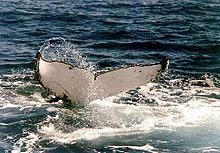fluke


The fluke is the tail fin of the whales and manatees . In contrast to the caudal fin of the fish , the one of these marine mammals is aligned horizontally to the body and is only held in shape by connective tissue, so it does not contain any bones, the spine ends in the fluke handle .
The horizontal orientation comes from the anatomy of the vertebral column in mammals. Mammals can move their spine better and more forcefully in the vertical direction (humans also paddle their feet and legs better "up and down" than "back and forth"); In fish, the preferred movement of the spine, in contrast to mammals, is horizontal (ie "back and forth"). The orientation of the fluke is therefore suitable for distinguishing fish from mammals.
From an evolutionary point of view, the external similarity of the fluke and the fish fin is an analogy . H. a parallel development due to similar environmental conditions.
The main purpose of the fluke is to propel it in water. It also plays a role in stabilizing the body in the water. Furthermore, a blood capillary system within the fluke enables a controlled temperature exchange with the environment. The fluke is also used by some whales as a tool for hunting: Killer whales in particular have seen prey being thrown out of the water with the fluke or stunned with a flick.
The fluke is often used to determine the type of whale and, in the case of some whale species, due to individual differences in pattern and shape, to identify the individual.